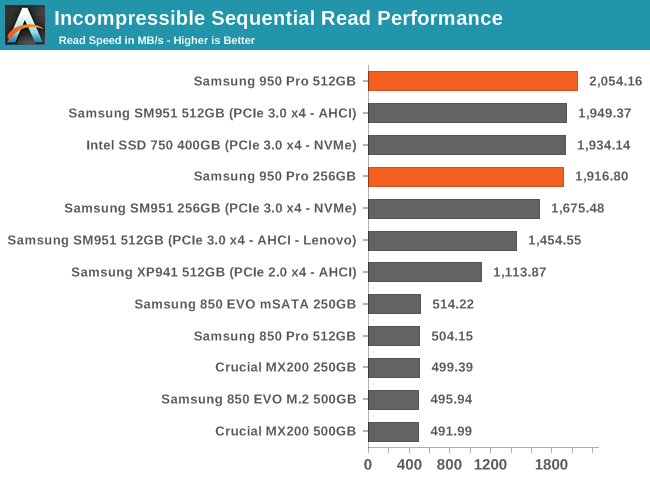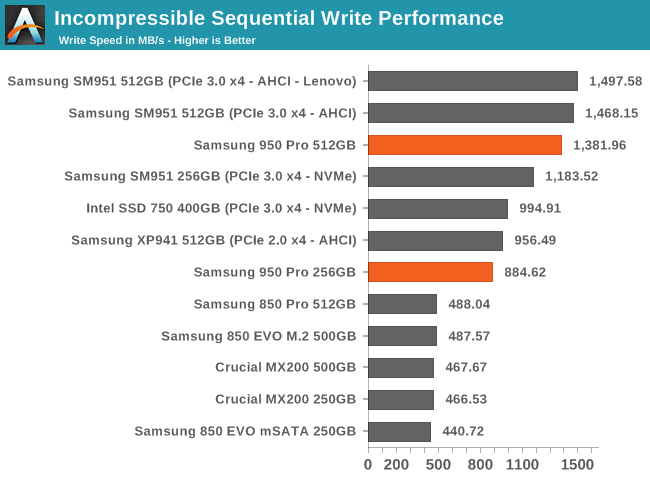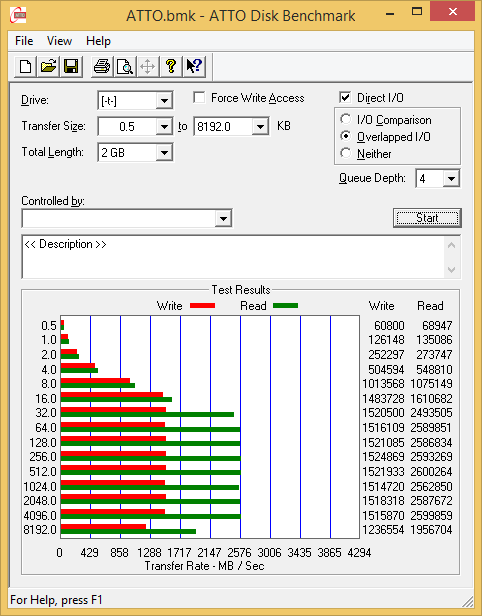The Samsung 950 Pro PCIe SSD Review (256GB and 512GB)
by Billy Tallis on October 22, 2015 10:55 AM ESTATTO - Transfer Size vs Performance
ATTO provides a quick and easy test of performance over a range of block sizes, which makes it a good overview of performance. It illustrates quite clearly how performance plateaus as transfer size increases, with reads bumping up against the limits of SATA but writes being limited by the speed of the flash itself.
AS-SSD Incompressible Sequential Performance
Any drives that perform transparent compression will perform much worse on this test than the Iometer tests. The SandForce controllers that relied heavily on compression are much less popular (having been largely displaced by controllers from Silicon Motion, Marvell, and Phison), but this in still an important metric to keep in the suite. Many real-world sources of bulk data (such as encoded video) are already heavily compressed and cannot benefit from any attempts at further compression.


With a freshly-wiped drive and the short duration of the AS-SSD test, the drives perform much closer to their advertised speeds.











142 Comments
View All Comments
bill.rookard - Sunday, October 25, 2015 - link
VERY interesting. Of particular note is the Crucial MX200 - an older drive, and connected via SATA which trades blows back and forth with the newer PCIe - nvme based drives. Wow, good stuff.Deders - Thursday, October 22, 2015 - link
I think it was only PCIe drives that had long booting times like the Intel 750.Gigaplex - Thursday, October 22, 2015 - link
These are PCIe drives.Deders - Friday, October 23, 2015 - link
I mean slotted drives as the drive controller has to load from the deviceKristian Vättö - Thursday, October 22, 2015 - link
I have a 256GB 950 PRO in my system (AsRock Z170 Extreme 7) and boot time is about 8 seconds with ultra fast boot enabled in BIOS/UEFI.Jacerie - Thursday, October 22, 2015 - link
Why would you go on about how awesome Skylake and the 100 series chipset are for PCIe connected drives and then use a Haswell chip and a Z97 board for the test rig? Time to go back to the bench.Billy Tallis - Thursday, October 22, 2015 - link
The Haswell system is what I've got on hand to test with, and it's what allows my results to be directly comparable with the reviews from earlier this year.Skylake gives you PCIe 3 from the PCH, but on the testbed we always use an x16 slot directly off the CPU for PCIe SSDs, so we don't need Skylake to run the drive at PCIe 3 speeds.
Jacerie - Thursday, October 22, 2015 - link
Will you be posting a follow-up to highlight any controller differences with the newer hardware?MrSpadge - Thursday, October 22, 2015 - link
This is not a SATA controller we're talking about, it's PCIe. And there we have hardly seen any differences between different implementations over the years.hansmuff - Thursday, October 22, 2015 - link
May I humbly request an addition to the review to show performance AND issues when using a PCI Express 2.0 to M.2 adapter on an older platform like the P67A?